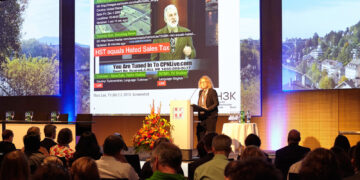Presentation on the conservation of digital art at the HEK

At the iPRES conference held in Bern in 2016, HEK Director Sabine Himmelsbach gave a keynote speech on the challenges of preserving digital art entitled "Net-based and Networked - Challenges for the Conservation of Digital Art“.
Digital art, in its countless manifestations, has become an integral part of contemporary art production. Its cultural relevance is unquestioned, but its conservation does present new challenges to museums and collections alike. After all, we are not talking about static objects that can be “stabilized” in the classical sense; rather, digital art is akin to performance because new conditions can arise in each process or each performance. What can be done if the technology is already out of date the moment you switch on the computer? How do we deal with works of art that are dependent on proprietary software that’s no longer being updated by its manufacturers, or whose manufacturer no longer exists? How can net-based projects be preserved for the future? In an era of rapid technological change and short-lived technologies, the question of how best to conserve our digital heritage is becoming increasingly urgent. Conservation of digital content and digital born art faces many problems – fragility, digital longevity and technological obsolescence are some of the concerns that have had to be dealt with for many years. Net-based and networked art are built and distributed within a complex system that often includes social media or other restricted platforms. Digital culture consists of "practices, not objects” - art, technology, media and social relations are merged into a networked process. We constantly have to adapt our tools and practices to fit the performative and processual practices of artworks we seek to preserve, works that are in a constant state of flux. To preserve web-based works of art, stakeholders of cultural heritage also have to deal with the inter-relatedness and rhizomatical structure of artworks that reference dynamic and real-time data sources and must develop new methods for the documentation of digital content.
With examples of works from the collection of HEK (House of Electronic Arts) as a unique institution with a pioneering role in Switzerland, the presentation gave insight into software-based artistic practice and the complex tasks of preservation of digital art that can be described as a networked process. HEK has focused on net-based works and preserves therefore an artistic practice that represents a particular challenge for musealization. The presentation focused on some of the challenges and opportunities in the conservation and contextualisation of these media art practices for museums, emphasizing the collaborative approach and cooperation beyond institutional borders.